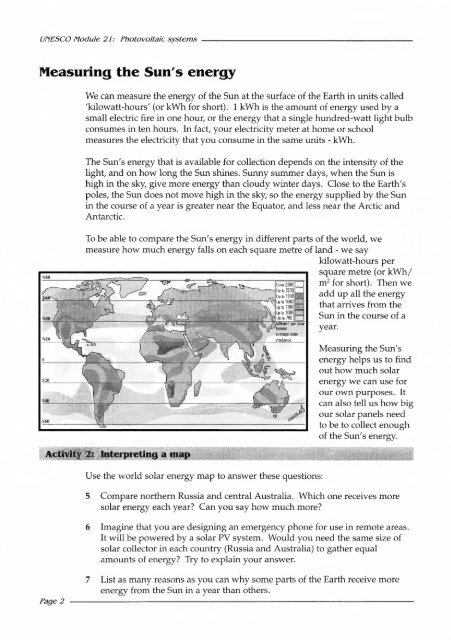UNESCO resource kit - science and technology educa...
UNESCO resource kit - science and technology educa...
UNESCO resource kit - science and technology educa...
Create successful ePaper yourself
Turn your PDF publications into a flip-book with our unique Google optimized e-Paper software.
<strong>UNESCO</strong> Nodule 21: Photovoltaic systems ---------------------<br />
Measuring the Sun's energy<br />
Page 2<br />
We can measure the energy of the Sun at the surface of the Earth in units called<br />
'kilowatt-hours' (or kWh for short). 1 kWh is the amount of energy used by a<br />
small electric fire in one hour, or the energy that a single hundred-watt light bulb<br />
consumes in ten hours. In fact, your electricity meter at home or school<br />
measures the electricity that you consume in the same units - kWh.<br />
The Sun's energy that is available for collection depends on the intensity of the<br />
light, <strong>and</strong> on how long the Sun shines. Sunny summer days, when the Sun is<br />
high in the sky, give more energy than cloudy winter days. Close to the Earth's<br />
poles, the Sun does not move high in the sky, so the energy supplied by the Sun<br />
in the course of a year is greater near the Equator, <strong>and</strong> less near the Arctic <strong>and</strong><br />
Antarctic.<br />
Tobe able to compare the Sun's energy in different parts of the world, we<br />
measure how much energy falls on each square metre of l<strong>and</strong> - we say<br />
kilowatt-hours per<br />
square metre (or kWh/<br />
m" for short). Then we<br />
add up all the energy<br />
that arrives from the<br />
Sun in the course of a<br />
year.<br />
Use the world solar energy map to answer these questions:<br />
Measuring the Sun's<br />
energy helps us to find<br />
out how much solar<br />
energy we can use for<br />
our own purposes. It<br />
can also tell us how big<br />
our solar panels need<br />
to be to collect enough<br />
of the Sun's energy.<br />
5 Compare northern Russia <strong>and</strong> central Australia. Which one receives more<br />
solar energy each year? Can you say how much more?<br />
6 Imagine that you are designing an emergency phone for use in remote areas.<br />
It will be powered by a solar PV system. Would you need the same size of<br />
solar collector in each country (Russia <strong>and</strong> Australia) to gather equal<br />
amounts of energy? Try to explain your answer.<br />
7 List as many reasons as you can why some parts of the Earth receive more<br />
energy from the Sun in a year than others.

















